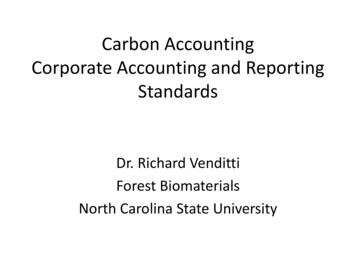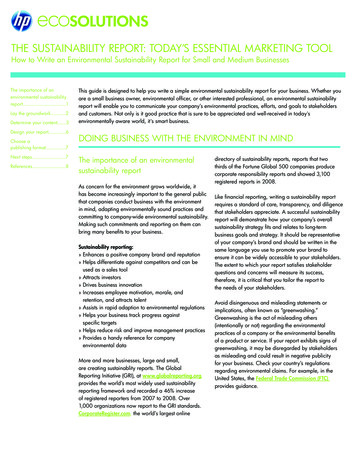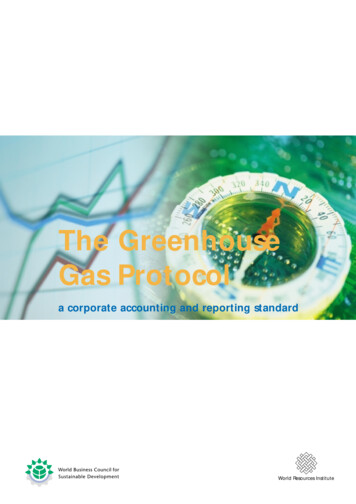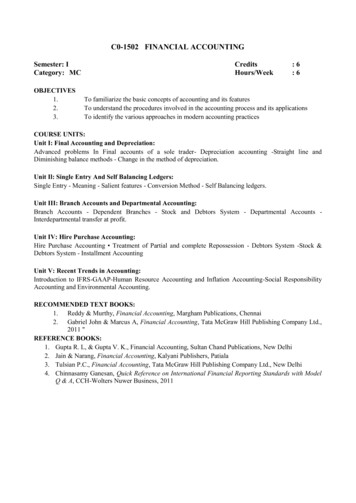
Transcription
TheGLOBAL GHGACCOUNTING& REPORTINGStandardF OR T H E F I NA NC I A L I N DUS T RY
Global GHG Accounting and Reporting Standard for the Financial IndustryThis standard has been reviewed by the GHG Protocol andis in conformance with the requirements set forth in theCorporate Value Chain (Scope 3) Accounting and ReportingStandard, for Category 15 investment activities.TheGLOBAL GHGACCOUNTING& REPORTINGStandardF OR T H E F I NA NC I A L I N DUS T RYPlease cite this document as:PCAF (2020). The Global GHG Accounting and ReportingStandard for the Financial Industry. First edition.November 18, 20202
Global GHG Accounting and Reporting Standard for the Financial TEAPCHReview and applyaccountingmethodologies foreach asset classTER2R1RTEAPCHReviewaccounting andreporting principlesand rulesRIdentifybusinessgoals3Understandwhat GHGaccounting isIntroductionTable of contentsAcknowledgements4Foreword by the PCAF Steering Committee6Foreword by Mark Carney7Executive summary81.Introduction112.The importance of GHG accounting183.Using GHG accounting to set and achieve business goals244.Principles and requirements of GHG accounting for financials324.1GHG accounting requirements derived from the GHG Protocol’s principles334.2Additional requirements for accounting and reporting financed emissions355.Methodology to measure financed emissions415.1Listed equity and corporate bonds475.2Business loans and unlisted equity585.3Project finance695.4Commercial real estate775.5Mortgages835.6Motor vehicle loans896.Reporting recommendations and 11310. Annex9711618-11-20203
Global GHG Accounting and Reporting Standard for the Financial IndustryAcknowledgementsIn September 2019, the Partnership for Carbon Accounting Financials (PCAF) was launchedglobally to harmonize greenhouse gas (GHG) accounting methods and enable financialinstitutions to consistently measure and disclose the GHG emissions financed by their loans andinvestments. These emissions are also called financed emissions or portfolio climate impact.As an industry-led partnership, PCAF is governed by a Steering Committee of ABN AMRO,Amalgamated Bank, ASN Bank, the Global Alliance for Banking on Values, Morgan Stanley, NMBBank, Triodos Bank, and a representative from the United Nations (UN)-convened Net-ZeroAsset Owner Alliance. At the time of publishing this document, more than 85 banks and investorsparticipate in PCAF.1 Out of this group, 16 volunteered to form the PCAF Core Team to co-createthe Global GHG Accounting and Reporting Standard for the Financial Industry with the ultimategoal of harmonizing greenhouse gas accounting. The PCAF Global Core Team is depicted below:The PCAF Secretariat facilitated the Core Team’s work by moderating their technical discussions,reviewing the content, and compiling and editing this document. The PCAF Secretariat isoperated by Guidehouse, a global consultancy firm specialized in energy, sustainability, risk, andcompliance for the financial industry.Observers to the process of developing the Global GHG Accounting and Reporting Standardfor the Financial Industry include Barclays, the Green Climate Fund, the General Council forIslamic Banks and Financial Institutions, and other organizations. As observers, these financialentities were proactively informed and involved in the development process of the Global GHG1The full list of PCAF participants can be found ons4
Global GHG Accounting and Reporting Standard for the Financial IndustryAccounting and Reporting Standard and had the opportunity to provide input and feedback.Observers’ participation does not imply official endorsement nor commitment to PCAF.Throughout the development of the Global GHG Accounting and Reporting Standard (October2019-November 2020), PCAF engaged with civil society organizations to consider their ideas,discuss PCAF methodological approaches, and receive feedback. During August and September2020, PCAF also held a public consultation with financial institutions, policy makers, dataproviders, consultants, and nongovernmental organizations (NGOs).This standard has been reviewed by the GHG Protocol and conforms with the requirements setforth in the Corporate Value Chain (Scope 3) Accounting and Reporting Standard for Category 15investment activities.5
Global GHG Accounting and Reporting Standard for the Financial IndustryForeword by the PCAF Steering CommitteeAs the urgency of the climate emergency grows with still-rising global greenhouse gases and proliferatingphysical impacts, increasing efforts are now being directed at how to prepare the global financial system tomanage carbon risks and bring solutions to the climate challenge, by bringing emissions down to net-zero.It is against that back drop that, as members of the Steering Committee for the Partnership for CarbonAccounting Financials (PCAF), we have been building what we believe to be an essential and crucialcomponent of the broader climate finance ecosystem. Since our global launch in September 2019, there hasbeen a surge of interest from banks and investors worldwide to have a clear and transparent set of rulesto measure their financed emissions to assess risk, manage impact, meet the disclosure expectations ofimportant stakeholders, and assess progress to global climate goals.We owe the globalization of PCAF to the pioneering work of the Dutch financial industry. In 2015, fourteenDutch financial institutions, led by ASN Bank, started the journey to develop methods to understand theirportfolios’ contribution to climate change—they strongly believed that measuring financed emissions wouldenable them to take informed actions to decarbonize their portfolios in order to minimize climate risksand maximize opportunities. They were right. By measuring financed emissions, they were able to identifycarbon-intensive hotspots and develop innovative low carbon products for their clients and investees. Theirwork reveals that measuring financed emissions is the cornerstone of informed climate actions. It is one ofthe first steps any financial institution should take when embarking upon a process to understand climaterisks and opportunities and assessing portfolio alignment in the context of the Paris Agreement.The PCAF Netherlands success led to the uptake of greenhouse gas accounting methods by NorthAmerican financial institutions in 2018. After being tried and tested in the Netherlands, Canada and theUnited States, and bolstered by a public commitment from pioneers of values-based banking from allcorners of the world to adopt this approach, many other financial institutions around the globe began toinquire about how this experience could be applied in other countries.We listened to our peers and understood that it was time to have harmonized methodologies to measurefinanced emissions that can be used by financial institutions of various sizes and with diverse modelswherever they are in the world. The Global GHG Accounting and Reporting Standard that you are about toread is a response to this global request.The Standard is the result of the tenacious work of financial institutions who are part of the PCAF GlobalCore Team, who volunteered their time to create it.We thank the William & Flora Hewlett Foundation and the Ikea Foundation for their generous support of thiswork, we thank the institutions we work for who provided us with the time to work on something that is ofbenefit to the industry as a whole, and we thank the hundreds of financial institutions, governmental andnongovernmental organizations who have helped bring this important idea to life.The PCAF Steering andahlforthcoming representative of theUN-convenedNet-Zero AssetOwner Alliance6
Global GHG Accounting and Reporting Standard for the Financial IndustryForeword by Mark CarneyTo achieve net zero emissions by 2050, we need a whole economy transition - every company,every bank, every insurer and investor will have to adjust their business models, develop credibleplans for the transition and implement them. Private finance will fund the initiative and innovationof these plans, provided that it has the necessary information, tools and markets.Financial firms will need to review more than the emissions generated by their own businessactivity. They must measure and report the financed emissions generated by the companies,properties and projects to which they lend. Some of the largest firms have already committed todoing so and the PCAF initiative will help many more to follow.The PCAF’s industry-led process demonstrates the sector’s recognition that climate change andthe transition to net zero is a risk that needs to be managed as well as an enormous commercialopportunity to grasp. For this to happen, the sector requires robust, clear and harmonizeddisclosure of financed emissions; it needs to embed climate risk management into businessdecisions; and direct capital to economic activities that enable the transition to net zero no laterthan 2050.The Global GHG Accounting and Reporting Standard for the Financial Industry is an importantmilestone that will serve to make significant progress on climate-related financial disclosures,addressing these three important requirements. By using the Standard, the industry will be ableto measure financed emissions, a metric that provides the starting point to assess and discloseclimate-related risks in line with the Task Force on Climate-related Financial Disclosures (TCFD);set science-based targets using emission-based methods developed by organizations like theScience Based Targets initiative (SBTi); and inform climate strategies and actions that directcapital to support the alignment of financial flows with the Paris Agreement’s goals.As we enter the one year countdown to COP26, now is the time to raise ambition and take action.Every bank, asset manager, asset owner and insurance company should consider how to set netzero targets and use the PCAF guidance to help the world achieve net zero.Mark CarneyFinance Adviser to the Prime Minister for COP 26 and UN Special Envoy forClimate Action and Finance7
Global GHG Accounting and Reporting Standard for the Financial IndustryExecutive summaryThe Partnership for Carbon Accounting Financials (PCAF) is an industry-led initiative. Createdin 2015 by Dutch financial institutions, PCAF extended to North America in 2018, and scaled upglobally in 2019. PCAF helps financial institutions assess and disclose the greenhouse gas (GHG)emissions from their loans and investments through GHG accounting.GHG accounting enables financial institutions to disclose these emissions at a fixed point intime and in line with financial accounting periods. Measuring financed emissions allows financialinstitutions to make transparent climate disclosures on their GHG emissions exposure, identifyclimate-related transition risks and opportunities, and set the baseline emissions for target settingin alignment with the Paris Agreement.Until now, there has not been a globally accepted standard for the measurement and disclosure offinanced emissions. The absence of harmonized methodologies and reporting rules has led to thepoor uptake of the accounting of financed emissions and inconsistent disclosures across financialinstitutions.Responding to industry demand for a global, standardized GHG accounting approach, PCAFdeveloped the Global GHG Accounting and Reporting Standard for the Financial Industry(the Standard). This Standard has been reviewed by the GHG Protocol and conforms withthe requirements set forth in the Corporate Value Chain (Scope 3) Accounting and ReportingStandard for category 15 investment activities.The Standard provides detailed methodological guidance for asset classes. Widely tested bybanks and investors, these methods assist in the measurement and disclosure of GHG emissionsassociated with six asset classes:Listed equity andcorporate bondsCommercial real estateBusiness loans andunlisted equityProject financeMortgagesMotor vehicle loans8
Global GHG Accounting and Reporting Standard for the Financial IndustryThe Standard provides detailed guidance for each asset class to calculate the financed emissionsresulting from activities in the real economy that are financed through lending and investmentportfolios. Emissions are attributed to financial institutions based on robust, consistentaccounting rules specific to each asset class. By following the methodologies for each, financialinstitutions can measure GHG emissions for each asset class and produce disclosures that areconsistent, comparable, reliable, and clear.Limited data is often the main challenge in calculating financed emissions; however, datalimitations should not deter financial institutions from starting their GHG accounting journeys.Beginning with estimated or proxy data can help identify carbon-intensive hotspots in lendingand investment portfolios. The Standard provides guidance on data quality scoring per assetclass, facilitating data transparency and encouraging improvements to data quality in the mediumand long term. The Standard also provides recommendations and requirements for disclosures,which include a minimum disclosure threshold with flexibility to report beyond this level. Anyrequirements not fulfilled must be accompanied by an explanation.Using this Standard equips financial institutions with standardized, robust methods to measurefinanced emissions and enables them to: Assess climate-related risks in line with the Task Force on Climate-related FinancialDisclosures (TCFD). Set science-based targets (SBTs) using methods developed by the Science Based Targetsinitiative. Report to stakeholders like the Carbon Disclosure Project (CDP). Inform climate strategies and actions to develop innovative products that support thetransition toward a net-zero emissions economy.9
WRI and WBCSD publishedCorporate Value Chain(Scope 3) Accounting andReporting Standard2011PCAF founded byDutch financialinstitutions2015PCAF published 2 reports onGHG accounting methodsPCAF launched inNorth America20192018PCAF launches Global GHGAccounting and Reporting Standardfor the Financial IndustryPCAF launched globally20192020Harmonizing and implementing acarbon accounting approach for thefinancial sector in North America6PFCsSFCorporate Value Chain(Scope 3) Accountingand Reporting uctsofAccounting GHG emissionsand taking action:harmonised approach for thefinancial sector in the NetherlandsAccounting GHG emissions and taking action: harmonised approach for the financial sector in the Netherlands PCAF The Netherlands, report 2019Supplement to the GHG Protocol CorporateAccounting and Reporting StandardTheGLOBAL GHGACCOUNTING& REPORTINGPCAF The Netherlands, report 2019StandardF OR T H E F I NA NC I A L I N DUS T RYUsing the Standard is the first step in the journeyto align with the Paris enario AnalysisSet TargetsTakeActionsNet-zero emissionsby 2050Monitor Progress!"# %&'()!"#)* 4)A1533)53)3 .B6) 91.BC))!"! # %&'()'* &,)-.()/01201-&')30.(%)!"# %&'()!"#)* )53)3 .B6) 91.BC)!"# %&'()!"#)* *#,)-./)011234/540.6).6)7589):;)54)4 9) .44. )?719539)239)4 9)35 9)!"# #%&'(&)*% ,"&#; 0, 5%&6*7 ( (,& !./@9/)79/)53394)A1533)53)3 .B6) 91.BC))-./0*,1*2,#%3*4, 5%&6*78"(#69 '7:#)-./0 7ᯯ( 7* %3"7*(&43"'(&)*4% !!"! # %&'()'* &,)-.()/01201-&')30.(%))!"! # %&'()'* &,)-.()/01201-&')30.(%)))!"# #%&'(&)*% ,"&#; 0, 5%&6*7 ( (,& !4"! 5 % .'%%)60-.%)-.() .6 %&'()'* &,)!"# %&'()!"#)* *#,)-./)011234/540.6).6)7589):;)54)4 9) .44. )?719539)239)4 9)35 9)-./0*,1*2,#%3*4, 5%&6*78"(#6 9 '7:#!"# %&'()!"#)* *#,)-./)011234/540.6).6)7589):;)54)4 9) .44. )?719539)239)4 9)35 9)This Standardwas reviewed by the GHG Protocol and)!"# #%&'(&)*% ,"&#./@9/)79/)53394)A1533)53)3 .B6) 91.BC)Over 85 financial institutions,; 0, 5%&6*7 ( (,& !-./0 7ᯯ( 7* %3"7*(&43"'(&)*4% !./@9/)79/)53394)A1533)53)3 .B6) 91.BC)with) over 17 Trillion in financial assetscommitted (November 2020).!"! # %&'()'* &,)-.()/01201-&')30.(%))-./0*,1*2,#%3*4, 5%&6*78"(#6 9 '7:#)-./0 7ᯯ( 7* %3"7*(&43"'(&)*4% !!"! # %&'()'* &,)-.()/01201-&')30.(%)))4"! 5 % .'%%)60-.%)-.() .6 %&'()'* &,)!"# #%&'(&)*% ,"&#); 0, 5%&6*7 ( (,& !is in conformancewith the requirements set forth in the!"# #%&'(&)*% ,"&#; 0, 5%&6*7 ( (,& !CorporateValue) Chain (Scope 3)9 '7:#Accountingand Reporting-./0*,1*2,#%3*4, 5%&6*78"(#6Standard,Category 15 investment activities.-./0 7ᯯ( 7* %3"7*(&43"'(&)*4% !4"!for5 % .'%%)60-.%)-.() .6 %&'()'* &,)!"# #%&'(&)*% ,"&#!"# %&'()!"#)* *#,)-./)011234/540.6).6)7589):;)54)4 9) .44. )?719539)239)4 9)35 9); 0, 5%&6*7 ( (,& !-./0*,1*2,#%3*4, 5%&6*78"(#6 9 '7:#-./0*,1*2,#%3*4, 5%&6*78"(#6 9 '7:#!"# #%&'(&)*% ,"&#./@9/)79/)53394)A1533)53)3 .B6) 91.BC); 0, 5%&6*7 ( (,& !-./0 7ᯯ( 7* %3"7*(&43"'(&)*4% !-./0*,1*2,#%3*4, 5%&6*78"(#6 9 '7:#-./0 7ᯯ( 7* %3"7*(&43"'(&)*4% !) )# %&'()'* &,)-.()/01201-&')30.(%)4"!!"!5 % .'%%)60-.%)-.() .6 %&'()'* &,)!"# #%&'(&)*% ,"&#!"# #%&'(&)*% ,"&#; 0, 5%&6*7 ( (,& !; 0, 5%&6*7 ( (,& !-./0*,1*2,#%3*4, 5%&6*78"(#69 '7:#-./0*,1*2,#%3*4, 5%&6*78"(#69 '7:#-./0 7ᯯ( 7* %3"7*(&43"'(&)*4% !-./0 7ᯯ( 7* %3"7*(&43"'(&)*4% !) )5 % .'%%)60-.%)-.() .6 %&'()'* &,)7"!4"!8109'/&): .-./')) )!"# #%&'(&)*% ,"&#); 0, 5%&6*7 ( (,& !-./0*,1*2,#%3*4, 5%&6*78"(#6 9 '7:#!"# #%&'(&)*% ,"&#; @1,?74#*7 ( (,& !-./0 7ᯯ( 7* %3"7*(&43"'(&)*4% !2,#%3*51,?74#*78"(#6 9 '7:#; @1,?74#*7 ( (,& !2,#%3*51,?74#*78"(#6 9 '7:#!"# #%&'(&)*% ,"&#; A"(3'(&)*7 ( (,& !)@1,571#6* %3"7*%#*,1()(&%#(,&)Businessand Unlisted Equity7"! Loans8109'/&): .-./')GHG accounting for six asset classes))7"! 8109'/&): .-./');"! 0 '1/ -6) '-6)?%&-&')))!"# #%&'(&)*% ,"&#!"# #%&'(&)*% ,"&#; @1,?74#*7 ( (,& !; A"(3'(&)*7 ( (,& !2,#%3*51,?74#*78"(#6 9 '7:#@1,571#6* %3"7*%#*,1()(&%#(,&);"! 0 '1/ -6) '-6)?%&-&')7"!) 8109'/&): .-./'))!"# #%&'(&)*% ,"&#;"! 0 '1/ -6) '-6)?%&-&')@"! A01&B-B'%)))-./0 7ᯯ( 7* %3"7*(&43"'(&)*4% !Commercial Real Estate; A"(3'(&)*7 ( (,& !@1,571#6* %3"7*%#*,1()(&%#(,&!"# #%&'(&)*% ,"&#; @1,?74#*7 ( (,& !2,#%3*51,?74#*78"(#6 9 '7:#))@"! A01&B-B'%);"!) 0 '1/ -6) '-6)?%&-&'))!"# #%&'(&)*% ,"&#; A"(3'(&)*7 ( (,& !@1,571#6* %3"7*%#*,1()(&%#(,&!"# #%&'(&)*% ,"&#; A"(3'(&)*7 ( (,& !@1,571#6* %3"7*%#*,1()(&%#(,&!)C"! A0&01)D'E /6')60-.%)@"!) A01&B-B'%))!"# #%&'(&)*% ,"&#; .7 (437*7 ( (,& !!"# #%&'(&)*% ,"&#; 0, 5%&6*7 ( (,& !7"! 8109'/&): .-./')-./0*,1*2,#%3*4, 5%&6*78"(#6 9 '7:#)4"! 5 % .'%%)60-.%)-.() .6 %&'()'* &,))-./0 7ᯯ( 7* %3"7*(&43"'(&)*4% !!"# #%&'(&)*% ,"&#!"# #%&'(&)*% ,"&#; 0, 5%&6*7 ( (,& !; @1,?74#*7 ( (,& !-./0*,1*2,#%3*4, 5%&6*78"(#69 '7:#2,#%3*51,?74#*78"(#6 9 '7:#))-./0 7ᯯ( 7* %3"7*(&43"'(&)*4% !!"# #%&'(&)*% ,"&#; @1,?74#*7 ( (,& !)2,#%3*51,?74#*78"(#69 '7:#))Listed) Equityand Corporate Bonds)))Mortgages!"# #%&'(&)*% ,"&#!"# #%&'(&)*% ,"&#; A"(3'(&)*7 ( (,& !; A"(3'(&)*7 ( (,& !@1,571#6* %3"7*%#*,1()(&%#(,&@1,571#6* %3"7*%#*,1()(&%#(,&)!@"! A01&B-B'%)C"! A0&01)D'E /6')60-.%)))7"! 8109'/&): .-./'));"! 0 '1/ -6) '-6)?%&-&')!"# #%&'(&)*% ,"&#))Project Finance;"! 0 '1/ -6) '-6)?%&-&'))@"! A01&B-B'%)!"# #%&'(&)*% ,"&#); A"(3'(&)*7 ( (,& !)@1,571#6* %3"7*%#*,1()(&%#(,&!"# #%&'(&)*% ,"&#; A"(3'(&)*7 ( (,& !)@1,571#6* %3"7*%#*,1()(&%#(,&@"! A01&B-B'%))C"! A0&01)D'E /6')60-.%)!"# #%&'(&)*% ,"&#)!Motor Vehicle Loans; A"(3'(&)*7 ( (,& !@1,571#6* %3"7*%#*,1()(&%#(,&!"# #%&'(&)*% ,"&#;.7 (437*7 ( (,& !!2,#%3* %3"7*%#*,1()(&%#(,&!C"! A0&01)D'E /6')60-.%))!"# #%&'(&)*% ,"&#The Partnership for Carbon Accounting Financials(PCAF); .7 (437*7 ( (,& !is an2,#%3* %3"7*%#*,1()(&%#(,&!industry-led initiative enabling financial institutions to measure and!!disclose greenhouse gas (GHG) emissions of loans and investments.C"! A0&01)D'E /6')60-.%)!"# #%&'(&)*% ,"&#!"# #%&'(&)*% ,"&#; A"(3'(&)*7 ( (,& !; .7 (437*7 ( (,& !@1,571#6* %3"7*%#*,1()(&%#(,&2,#%3* %3"7*%#*,1()(&%#(,&)!"# #%&'(&)*% ,"&#; .7 (437*7 ( (,& !2,#%3* %3"7*%#*,1()(&%#(,&
1. Introduction11. Introduction1FAKE FOOTNOTE TO START AT APTERR43RRTEAPCHCHAPTER2TEAPAPCHReviewReview and apply Review and applyIdentifyReviewReportaccounting and reporting principlesreportingmethodologiesprinciples for methodologiesforgoalsand rulesandeachrulesasset class each asset classTER21RTEER1PTCHCHAPTECHRAAPCHAPTER1accounting is3UnderstandIdentifywhat onIntroductionwhat GHGIntroduction
Global GHG Accounting and Reporting Standard for the Financial IndustryThe role of the financial sectorUnder current national and international policies, the planet is on a trajectory to reach a globalincrease in temperature between 2.1 C and 3.9 C by 2100 compared to pre-industrial levels.2There is an urgent need to act in the short term for our long-term benefit. To limit global warmingto 1.5 C above preindustrial levels, all sectors of society need to decarbonize and collectivelyreach net-zero emissions by 2050. The financial sector can help facilitate the transition in linewith a 1.5 C scenario by directing capital to support decarbonization.To trigger changes in capital flows and signals for all sectors, the financial industry mustacknowledge and endorse the need for and pace of decarbonization. The industry should beginby better understanding the climate risks to their portfolio and the greenhouse gas (GHG)emissions (or climate impact) associated with their loans and investments. Measuring financedemissions is crucial in providing this understanding. If financial institutions know the emissionsfinanced by loans and investments, they can better identify and manage risks, navigate emissionsreduction goals, act to reduce their portfolio climate impact, and disclose progress. Thisunderstanding then triggers internal discussions and engagements with stakeholders to identifyconcrete actions that help lower financed emissions.The role of PCAF and GHG emissions accounting in reporting,managing risks and opportunities, and aligning financial flows withthe Paris AgreementPreviously, financial institutions used different approaches and accounting methodologies tomeasure financed emissions and opted for various reporting metrics, leading to inconsistentassessments of the industry’s climate impact. This lack of standardization hampers transparency,comparability, and accountability of the financial sector.With this issue in mind, banks, investors, and fund managers from five continents partneredto create the Partnership for Carbon Accounting Financials (PCAF).3 Committed to themeasurement and disclosure of the absolute GHG emissions of their portfolios (financedemissions), this industry-led initiative is rapidly expanding in North America, Latin America,Europe, Africa, and Asia Pacific.4 PCAF aims to standardize the way financial institutions measureand disclose financed emissions and increase the number of financial institutions that commit tomeasuring and disclosing financed emissions.Measuring financed emissions is critical for financial institutions that want to improve theirclimate reporting. Measuring and transparently reporting financed emissions helps financialinstitutions and their stakeholders understand the climate impact of the organization’s lendingand investment activities.Additionally, financed emissions provide useful information to identify and manage climaterelated transition risks and opportunities. For example, financed emissions can be used as a234(New Climate Institute and Climate Analytics, 2020)More information about PCAF is found at: https://carbonaccountingfinancials.com/A full list of PCAF participants is found ons12
Global GHG Accounting and Reporting Standard for the Financial Industrymetric to stress test the resilience of portfolios against climate policies that could have a materialeffect on the viability of an activity (e.g., carbon pricing). This information is helpful to developrisk management strategies and to identify business opportunities that could support riskmanagement and the transition to a low carbon economy.Lastly, accounting for financed emissions is an important part of the process that banks andinvestors take when aligning their lending and investment portfolios with the goals of the ParisAgreement. This process has five non-linear stages: Measuring and disclosing financed emissionsSetting science-based targets (SBTs)Designing strategies to reach the targetsImplementing concrete actions to achieve the targetsFinancial institutions also measure financed emissions to evaluate their progress against theiremissions-based targets.Relationship with other financial sector climate initiativesMultiple climate initiatives for financial institutions have been launched, including high levelcommitments, scenario analysis, target setting, and concrete climate action and reporting. Highlevel commitments and policies endorsed by C-suite executives drive financial institutions toaddress climate change. Measuring financed emissions provides the base year emissions forscenario analysis and target setting, informs climate actions, and enables reporting (Figure 1-1).Figure 1-1. Measuring financed emissions as the foundation for other initiativesSource: (PCAF, 2020)13
Global GHG Accounting and Reporting Standard for the Financial IndustryThere are a number of climate initiatives with a specific target audience and focus in each ofthese areas (Figure 1-2).PCAF focuses on measuring financed emissions, complementing the work and services that otherinitiatives offer to financial institutions. Building synergies is core to PCAF’s work, which has led tocollaborations with the following initiatives: United Nations Environment Programme Finance Initiative (UNEP FI) Principles forResponsible Banking and its Collective Commitment to Climate Action United Nations-convened Net-Zero Asset Owner Alliance Task Force on Climate-related Financial Disclosures (TCFD) Science Based Targets initiative for Financial Institutions (SBTi-FIs) Center for Climate-Aligned Finance of Rocky Mountain Institute Carbon Disclosure Project (CDP) European Commission Technical Expert Group on Sustainable Finance (EU TEG)Figure 1-2. Cluster of climate initiativesFor whom?BBanksIInvestorsBIBanks & InvestorsFocus ofInitiativeHigh-levelCommitmentto tsettingEnablingActionReportingUN Environment Program for Financial Institutions (UNEP FI) PrinciplesB forResponsible Banking (PRB): Collective Commitment on Climate ActionClimate Action in Financial InstitutionsBIInvestor Agenda: Investor Agenda Climate Plan (IACP)BIUN Global Compact: Business Ambition for 1.5 CIU.N.-Convened Net-Zero Asset Owner AllianceBITask Force on Climate-related Financial Disclosures (TCFD)BIPartnership for Carbon Accounting Financials (PCAF)BIRMI Center for Climate-Aligned FinanceB I 2dii Paris Agreement Capital Transition Assessment (PACTA)IBIIIGCC Paris Aligned Investment Initiative (PAII)SBTi-FinanceIClimate Action 100 BClimate Safe Learning LabBIPowering Past Coal Alliance Finance PrinciplesBIBankers for ClimateBI2dii Evidence for ImpactBICDP Financial Services QuestionnaireSource: (PCAF, 2020)14
Global GHG Accounting and Reporting Standard for the Financial IndustryStandardizing GHG emissions accounting for financial institutionsThis document is the first edition of the Global GHG Accounting and Reporting Standard forthe Financial Industry. Throughout this document, the Global GHG Accounting and ReportingStandard is commonly referred to as the Standard. The purpose of the Standard is to providefinancial institutions with transparent, harmonized methodologies to measure and report theemissions they finance through loans and investments in conformance with the requirements ofthe GHG Protocol Corporate Value Chain (Scope 3) Accounting and Reporting Standard.The Global GHG Accounting and Reporting Standard was developed by the PCAF GlobalCore Team, a heterogeneous group of banks and investors of varied sizes and from differentregions. This Core Team has wide experience in GHG accounting and consists of: ABN AMRO,Access Bank, Amalgamated Bank, Banco Pichincha, Bank of America, Boston Common AssetManagement, Crédit Coopératif and its subsidiary Ecofi, FirstRand Ltd., FMO, KCB, Landsbankinn,Morgan Stanley, Produbanco, Robeco, Triodos Bank, and Vision Banco.At the end of October 2019, the PCAF Global Core Team kicked off its activities by selecting a setof asset classes that are typical for banks, asset owners, and asset managers globally. These assetclasses are the focus of this first edition of the Global GHG Accounting and Reporting Standard.As the Standard and PCAF evolve, additional asset classes and case studies will be added. TheStandard currently covers the following asset classes:Listed equity andcorporate bondsCommercial real estateBusiness loans andunlisted equityProject financeMortgagesMotor vehicle loansThroughout the development of the Standard (October 2019-Novembe
Global GHG Accounting and Reporting Standard for the Financial Industry Executive summary The Partnership for Carbon Accounting Financials (PCAF) is an industry-led initiative. Created in 2015 by Dutch financial institutions, PCAF extended to North America in 2018, and scaled up globally in 2019.










